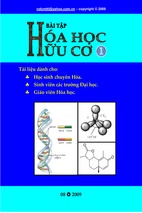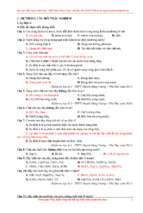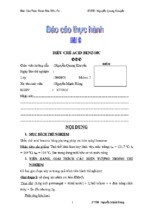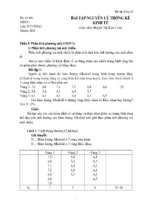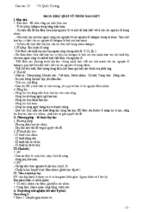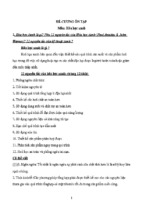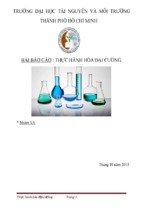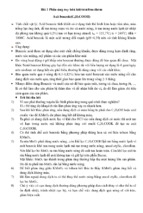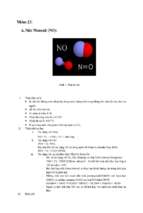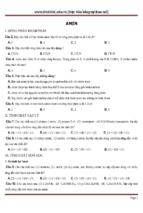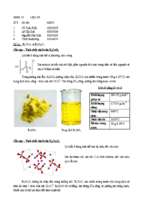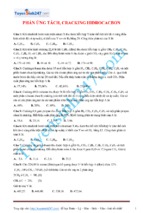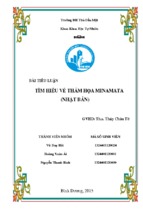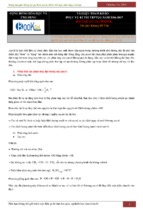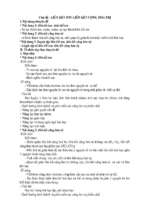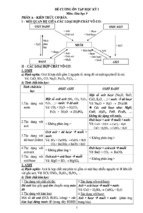Modern Organic Synthesis Lecture Notes - Dale L Boger
Lecture Notes
Modern Organic
Synthesis
Dale L. Boger
The Scripps Research Institute
Coordinated by Robert M. Garbaccio
Assembled by
Conformational Analysis
Steven L. Castle
Kinetics and Thermodynamics
Reaction Mechanisms
and Conformational Effects
Richard J. Lee
Oxidation Reactions and
Alcohol Oxidation
Bryan M. Lewis
Christopher W. Boyce
Reduction Reactions and
Hydroboration Reactions
Clark A. Sehon
Marc A. Labroli
Enolate Chemistry and
Metalation Reactions
Jason Hongliu Wu
Robert M. Garbaccio
Key Ring Transformations
Wenge Zhong
Jiyong Hong
Brian M. Aquila
Mark W. Ledeboer
Olefin Synthesis
Gordon D. Wilkie
Conjugate Additions
Robert P. Schaum
Synthetic Analysis and Design
Robert M. Garbaccio
Combinatorial Chemistry
Joel A. Goldberg
TSRI Press
La Jolla, CA
Copyright © 1999 TSRI Press. All rights reserved.
All rights reserved. No part of this publication may be reproduced, stored in a retrieval system or transmitted in
any form or by any means: electronic, electrostatic, magnetic tape, mechanical, photocopying, recording or otherwise, without permission in writing from the publisher.
Print First Edition 1999
CD Version 1.0 (1999)
CD Version 1.01 (2000)
CD Version 1.02 (2001)
ISBN
Flexicover
The CD versions of the Lecture Notes (Versions 1.01 and 1.02) contain corrections and updates to the science and will differ
slightly from the printed text (First Edition, 1999). We anticipate that this will continue on an annual basis, as with any set of
classroom lecture notes. Consequently, we would like to encourage you to inform us of mistakes you might find and we
welcome suggestions for additions to the content. In fact, if we are provided ChemDraw files of science you would like to see
included, the barriers to its incorporation are minimized.
The text of the CD may be searched by Adobe Acrobat Reader and this may be used in lieu of an index.
Printed and Bound in the U.S.A. by Rush Press, San Diego, California
Introduction
Dale L. Boger
Preface
The notes have been used as the introductory section of a course on Modern Organic Synthesis that composes 6 weeks or a little more than one-half of a quarter course at The Scripps Research Institute, Department of
Chemistry. Consequently, an exhaustive treatment of the individual topics is beyond the scope of this portion of
the course. The remaining 4 weeks of the quarter delve into more detail on various topics and introduce concepts
in multistep organic synthesis (E. Sorensen). For our students, this is accompanied by a full quarter course in
physical organic chemistry and is followed by a full quarter course on state of the art natural products total
synthesis (K. C. Nicolaou, E. Sorensen) and a quarter elective course on transition metal chemistry. Complementary to these synthetic and mechanistic courses, two quarter courses on bioorganic chemsitry and an elective
course on the principles of molecular biology and immunology are available to our students. Efforts have been
made to not duplicate the content of these courses. For those who might examine or use the notes, I apologize for
the inevitable oversight of seminal work, the misattribution of credit, and the missing citations to work presented.
The original notes were not assembled with special attention to this detail, but rather for the basic content and the
‘nuts and bolts’ laboratory elements of organic synthesis. In addition, some efforts were made to highlight the
chemistry and contributions of my group and those of my colleagues for the intrinsic interest and general appreciation of our students. I hope this is not mistaken for an effort to unduly attribute credit where this was not intended.
We welcome any suggestions for content additions or corrections and we would be especially pleased to receive
even minor corrections that you might find. – Dale L. Boger
Heinrich Friedrich von Delius (1720–1791)
is credited with introducing chemistry into the
academic curriculum.
Acknowledgments
Significant elements of the material in the notes were obtained from the graduate level organic synthesis
course notes of P. Fuchs (Purdue University) and were influenced by my own graduate level course taught by E. J.
Corey (Harvard). They represent a set of course notes that continue to evolve as a consequence of the pleasure of
introducing young colleagues to the essence and breadth of modern organic synthesis and I thank them for the
opportunity, incentive, and stimulation that led to the assemblage of the notes. Those familiar with ChemDraw
know the efforts that went into reducing my hand drafted notes and those maintained by Robert J. Mathvink
(Purdue University) and Jiacheng Zhou (The Scripps Research Institute) to a ChemDraw representation. For this,
I would like to thank Robert M. Garbaccio for initiating, coordinating, proofing and driving the efforts, and Steve,
Richard, Chris, Bryan, Clark, Marc, Jason, Rob, Wenge, Jiyong, Brian, Mark, Gordon, Robert and Joel for reducing the painful task to a reality. Subsequent updates have been made by Steven L. Castle (Version 1.01) and Jiyong Hong
(Version 1.02).
i
Modern Organic Chemistry
The Scripps Research Institute
It is a pleasure to dedicate this book and set of notes to Richard Lerner who is responsible for their appearance.
His vision to create a chemistry program within Scripps, his energy and enthusiasm that brought it to fruition, his support for
the graduate program and committment to its excellence, and his personal encouragement to this particular endeavour of
developing a graduate level teaching tool for organic synthesis, which dates back to 1991, made this a reality.
Antoine L. Lavoisier, universally regarded as the founder of modern chemistry, published in 1789 his
Elementary Treatise on Chemistry that distinguished between elements and compounds, initiated
the modern system of nomenclature, and established the oxygen theory of combustion. He and his
colleagues founded Annales de Chemie in 1789, he earned his living as a tax official and his “chemical revolution” of 1789 coincided with the start of the violent French Revolution (1789−1799). He
was executed by guillotine in 1794.
Jons Jacob Berzelius (1779–1848), a Swedish chemist, discovered cerium, produced a precise
table of experimentally determined atomic masses, introduced such laboratory equipment as test
tubes, beakers, and wash bottles, and introduced (1813) a new set of elemental symbols based on the
first letters of the element names as a substitute for the traditional graphic symbols. He also coined the
term “organic compound” (1807) to define substances made by and isolated from living organisms
which gave rise to the field of organic chemistry.
ii
Introduction
Dale L. Boger
Table of Contents
I.
Conformational Analysis
A. Acyclic sp3–sp 3 Systems
B. Cyclohexane and Substituted Cyclohexanes, A Values (∆G°)
C. Cyclohexene
D. Decalins
E. Acyclic sp3–sp2 Systems
F. Anomeric Effect
G. Strain
H. pKa of Common Organic Acids
1
1
2
7
7
8
12
14
16
II.
Kinetics and Thermodynamics of Organic Reactions
A. Free Energy Relationships
B. Transition State Theory
C. Intramolecular Versus Intermolecular Reactions
D. Kinetic and Thermodynamic Control
E. Hammond Postulate
F. Principle of Microscopic Reversibility
17
17
18
18
20
21
22
III.
Reaction Mechanisms and Conformational Effects on Reactivity
A. Ester Hydrolysis
B. Alcohol Oxidations
C. SN2 Reactions
D. Elimination Reactions
E. Epoxidation by Intramolecular Closure of Halohydrins
F. Epoxide Openings (SN2)
G. Electrophilic Additions to Olefins
H. Rearrangement Reactions
I. Pericyclic Reactions
J. Subtle Conformational and Stereoelectronic Effects on Reactivity
K. Methods for the Synthesis of Optically Active Materials
23
23
25
25
26
29
29
30
31
33
36
39
IV.
Oxidation Reactions
A. Epoxidation Reactions
B. Additional Methods for Epoxidation of Olefins
C. Catalytic Asymmetric Epoxidation
D. Stoichiometric Asymmetric Epoxidation
E. Baeyer–Villiger and Related Reactions
F. Beckmann Rearrangement and Related Reactions
G. Olefin Dihydroxylation
H. Catalytic and Stoichiometric Asymmetric Dihydroxylation
I. Catalytic Asymmetric Aminohydroxylation
J. Ozonolysis
41
41
51
56
67
67
70
74
81
84
86
V.
Oxidation of Alcohols
A. Chromium-based Oxidation Reagents
87
87
iii
Modern Organic Chemistry
The Scripps Research Institute
B. Manganese-based Oxidation Reagents
C. Other Oxidation Reagents
D. Swern Oxidation and Related Oxidation Reactions
89
90
93
Reductions Reactions
A. Conformational Effects on Carbonyl Reactivity
B. Reactions of Carbonyl Groups
C. Reversible Reduction Reactions: Stereochemistry
D. Irreversible Reduction Reactions: Stereochemistry of Hydride Reduction Reactions
and Other Nucleophilic Additions to Carbonyl Compounds
E. Aluminum Hydride Reducing Agents
F. Borohydride Reducing Agents
G. Hydride Reductions of Functional Groups
H. Characteristics of Hydride Reducing Agents
I. Asymmetric Carbonyl Reductions
J. Catalytic Hydrogenation
K. Dissolving Metal Reductions
L. Amalgam-derived Reducing Agents
M. Other Reduction Methods
95
95
96
96
97
112
113
115
118
124
127
128
134
136
VII.
Hydroboration–Oxidation
A. Mechanism
B. Regioselectivity
C. Diastereoselectivity
D. Metal-catalyzed Hydroboration
E. Directed Hydroboration
F. Asymmetric Hydroboration
139
139
140
140
143
144
144
VIII.
Enolate Chemistry
A. Acidic Methylene Compounds
B. Enolate Structure
C. Enolate Alkylations
D. Enolate Generation
E. Alkylation Reactions: Stereochemistry
F. Asymmetric Alkylations
G. Aldol Addition (Condensation)
H. Aldol Equivalents
I. Enolate-imine Addition Reactions
J. Claisen Condensation
K. Dieckmann Condensation
L. Enolate Dianions
M. Metalloimines, Enamines and Related Enolate Equivalents
N. Alkylation of Extended Enolates
147
147
155
156
159
168
175
179
197
199
200
201
203
203
206
IX.
Metalation Reactions
A. Directed Metalation
B. Organolithium Compounds by Metal–Halogen Exchnage
C. Organolithium Compounds by Metal–Metal Exchange (Transmetalation)
D. Organolithium Compounds from the Shapiro Reaction
E. Key Organometallic Reactions Enlisting Metalation or Transmetalation Reactions
207
207
210
211
211
212
VI.
iv
Introduction
Dale L. Boger
X.
Key Ring Forming Reactions
A. Diels–Alder Reaction
B. Robinson Annulation
C. Birch Reduction
D. Dieckmann Condensation
E. Intramolecular Nucleophilic Alkylation
F. Intramolecular Aldol Condensation
G. Intramolecular Michael Reaction
H. Cation–Olefin Cyclizations
I. Free Radical Cyclizations
J. Anionic Cyclizations
K. 1,3-Dipolar Cycloadditions
L. [1,3]-Sigmatropic Rearrangements
M. Electrocyclic Reactions
N. Nazarov Cyclization
O. Divinylcyclopropane Rearrangement
P. Carbene Cycloaddition to Alkenes
Q. [2 + 3] Cycloadditions for 5-Membered Ring Formation
R. Cyclopropenone Ketal Cycloaddition Reactions
S. [2 + 2] Cycloadditions
T. Arene–Olefin Photoadditions
U. Intramolecular Ene Reaction
V. Oxy–Ene Reaction: Conia Reaction
W. Cyclopentenone Annulation Methodology
X. Pauson–Khand Reaction
Y. Carbonylation Cyclizations
Z. Olefin Ring Closing Metathesis
213
213
271
287
287
287
288
288
289
301
321
322
326
328
328
330
331
336
339
343
346
347
349
350
353
355
356
XI.
Olefin Synthesis
A. Wittig Reaction
B. Wadsworth–Horner–Emmons Reaction
C. Peterson Olefination
D. Tebbe Reaction and Related Titanium-stabilized Methylenations
E. Other Methods for Terminal Methylene Formation
F. Olefin Inversion Reactions
G. [3,3]-Sigmatropic Rearrangements: Claisen and Cope Rearrangements
H. [2,3]-Sigmatropic Rearrangements
I. Olefin Synthesis Illustrated with Juvenile Hormone
359
359
365
367
370
371
372
374
378
381
XII.
Conjugate Additions: Organocuprate 1,4-Additions
395
XIII.
Synthetic Analysis and Design
A. Classifications
B. Retrosynthetic Analysis
C. Strategic Bond Analysis
D. Total Synthesis Exemplified with Longifolene
427
428
431
440
443
XIV.
Combinatorial Chemistry
461
v
Conformational Analysis
Dale L. Boger
I. Conformational Analysis
A. Acyclic sp3–sp3 Systems: Ethane, Propane, Butane
staggered
eclipsed
H
1. Ethane
H
H
H
H
H
1.0 kcal
H
H
60° rotation
HH
H
H
H
HH
H
H
H
E
3
rel. E
2
(kcal)
1
E
3.0 kcal
S
0
H
H
H
E
60
S
120
60° rotation
180
S
240
300
360
dihedral angle
H
H
H
- Two extreme conformations, barrier to rotation is 3.0 kcal/mol.
eclipsed
H
2. Propane
H
CH3
H
H
H
H
CH3
HH
1.3 kcal
60° rotation H
HH
H
fully eclipsed
(synperiplanar)
E
3.3 kcal
S
S
60
120
180
S
240
300
360
dihedral angle
H
- Barrier to rotation is 3.3 kcal/mol.
- Note: H/H (1.0 kcal) and Me/H (1.3 kcal) eclipsing interactions are
comparable and this is important in our discussions of torsional strain.
gauche
(synclinal)
H
H3C
CH3
E
CH3 60° rotation
1.0 kcal each
H3C
E
0
H
H
3. Butane
4
rel. E 3
(kcal) 2
1
staggered
H
H
CH3
H
H
H
H3C
CH3
staggered
(antiperiplanar)
H3C
H
H
H
H
H
CH3
H
H CH3
gauche
interaction
4.0 kcal
1.3 kcal each
0.9 kcal
H3C
H3C
CH3
CH3
H
CH3
60° rotation H
60° rotation H
CH3 60° rotation
H
H
HH
HH
HH
H
H
CH3
H
H
H
CH3
H
H
H
H
eclipsed
(anticlinal)
H
H
H
H
1.0 kcal each
6
5
4
rel. E
(kcal) 3
2
1
1.0 kcal
FE
FE
E
E
- Note: the gauche butane
interaction and its magnitude
(0.9 kcal) are very important
and we will discuss it frequently.
6.0
kcal
G
3.6 kcal
0.9 kcal
0
60
120
G
S
180
240
300
360
dihedral angle
1
Modern Organic Chemistry
The Scripps Research Institute
4. Substituted Ethanes
- There are some exceptions to the lowest energy conformation. Sometimes, a gauche
conformation is preferred over staggered if X,Y are electronegative substituents.
cf: Kingsbury J. Chem. Ed. 1979, 56, 431.
X
H
X
Y
H
H
H
H
Y
X
H
H
H
H
H
H
H
Y
gauche
H
X
H
H
Y
H
staggered
Egauche < Estaggered if X = OH, OAc and Y = Cl, F
5. Rotational Barriers
H
H
H
H
H
H
H
H
H
CH3
H
H
H
H
H
2.88 kcal/mol
(3.0 kcal/mol
3.40 kcal/mol
3.3 kcal/mol
H
CH3
H3C
H
H
CH3
CH3
H
CH3
3.90 kcal/mol
3.6 kcal/mol
4.70 kcal/mol
3.9 kcal/mol)
- Experimental
- Simple prediction
- The rotational barrier increases with the number of CH3/H eclipsing interactions.
H
H
H
H
H
H
H
2.88 kcal/mol
(3.0 kcal/mol
H
H
H
H
H
N
••
1.98 kcal/mol
2.0 kcal/mol
••
H
H
O
••
H
- Experimental
- Simple prediction
1.07 kcal/mol
1.0 kcal/mol)
- The rotational barrier increases with the number of H/H eclipsing interactions.
B. Cyclohexane and Substituted Cyclohexanes, A Values (∆G°)
1. Cyclohexane
4
Hax
1
Heq
3 2
chair
5 6
4
6
5
3
Ea = 10 kcal
Heq
1
Hax
chair
2
4 atoms in plane
H
HH
H
H
H
H
HH
H
H
half chair
(rel E = 10 kcal)
2
H
H
H
H
H
H
twist boat
(rel E = 5.3 kcal)
H
HH
HH
H
H
half chair
(rel E = 10 kcal)
Conformational Analysis
Dale L. Boger
- Chair conformation (all bonds staggered)
Hax Hax Hax
Heq
Heq
Heq
Heq
Hax Hax Hax
- Rapid interconversion at 25 °C (Ea = 10 kcal/mol, 20 kcal/mol available at 25 °C).
- Hax and Heq are indistinguishable by 1H NMR at 25 °C.
- At temperatures < –70 °C, Heq and Hax become distinct in 1H NMR.
- Boat conformation
2.9 kcal
flagpole interaction
H Hax
H
Heq
H
H
H
H
H
Hax
H
Hax
H
Heq
1.0 kcal
each (4x)
- Rel E = 6.9 kcal, not local minimum on energy surface.
- More stable boat can be obtained by twisting (relieves
flagpole interaction somewhat).
- Twist boat conformation (rel E = 5.3 kcal) does represent
an energy minimum.
- The boat conformation becomes realistic if flagpole
interactions are removed, i.e.
O
X
- Half chair conformation
H
HH
D.H.R. Barton received the 1969
Nobel Prize in Chemistry for his
contributions to conformational
analysis, especially as it relates to
steroids and six-membered rings.
Barton Experientia 1950, 6, 316.
H
H
HH
H
- Energy maximum (rel E = 10.0 kcal)
10
half
chair
half
chair
rel E
(kcal)
5
10 kcal
twist boat
5.3 kcal
0
chair
chair
3
Modern Organic Chemistry
The Scripps Research Institute
2. Substituted Cyclohexanes
- Methylcyclohexane
H
H
CH3
H
∆G° = –RT(ln K)
–1.8 × 1000
1.99 × 298 = –ln K
CH3
H
1.8 kcal more stable
K = 21
- The gauche butane interaction is most often identifiable as 1,3-diaxial interactions.
H
H
H
H
H
H
H
CH3
H
H
H
H
H
H
CH3
H
H
2 gauche butane interactions
2 × 0.9 kcal = 1.8 kcal
(experimental 1.8 kcal)
H
H
H
0 gauche butane interactions
- A Value (–∆G°) = Free energy difference between equatorial and axial
substituent on a cyclohexane ring.
Typical A Values
R
F
Cl
Br
I
OH
OCH3
OCOCH3
NH2
NR2
CO2H
CO2Na
CO2Et
SO2Ph
A Value (kcal/mol)
0.25
0.52
0.5–0.6
R
ca. 0.5 kcal
0.46
0.7 (0.9)
0.75
0.71
1.8 (1.4)
2.1
1.2 (1.4)
2.3
1.1
2.5
ca. 0.7 kcal
(2nd atom effect
very small)
A Value (kcal/mol)
0.2
0.41
NO2
CH=CH2
CH3
1.1
1.7
1.8
CH2CH3
nC H
3 7
2nd atom
1.9 (1.8)
effect very
2.1
small
2.1
2.1
>4.5 (ca. 5.4)
3.1 (2.9)
nC
4H9
CH(CH3)2
C(CH3)3
C6H5
- Note on difference between iPr and tBu A values.
H
CH3
CH3
H3C
H
H
CH3
CH3
H
H
4
Small, linear
CN
C CH
iPr
group can position
H toward "inside,"
but tBu group cannot.
Very serious interaction, 7.2 kcal.
groups
Conformational Analysis
Dale L. Boger
- Determination of A value for tBu group.
0.9 kcal
CH3
7.2 kcal H3C
H
H
CH3
H
H
∆G° = (9.0 kcal – 3.6 kcal)
= 5.4 kcal
H
H
CH3
H
CH3
H
CH3
0.9 kcal
7.2 kcal + (2 × 0.9 kcal) = 9.0 kcal
0.9 kcal each
4 × 0.9 kcal = 3.6 kcal
- Note on interconversion between axial and equatorial positions.
H
Cl
H
Cl
t1/2 = 22 years at –160 °C
Even though Cl has a small A value (i.e., small ∆G° between rings
with equatorial and axial Cl group), the Ea (energy of activation)
is high (it must go through half chair conformation).
trans-1,2-dimethylcyclohexane
H
H
H
CH3
H
H
H
2.7 kcal/mol more stable
CH3
H
H
H
H
H
H
CH3
CH3
H
CH3
H
cis-1,2-dimethylcyclohexane
H
H
H
H
H
CH3
4 × (gauche interaction)
4 × (0.9 kcal) = 3.6 kcal
H
H
H
H
H
H
H
CH2
H
CH3
∆E = 0 kcal/mol
H
H
CH3
H
CH3
H
H
1 × (gauche interaction)
1 × (0.9 kcal) = 0.9 kcal
H
CH3 H
CH2
H
H
CH3
CH3
H
CH2
H
H
3 × (gauche interaction)
3 × (0.9 kcal) = 2.7 kcal
H2/Pt
CH3
H
H
H
H
H
H
H
H
CH2
CH3 H
3 × (gauche interaction)
3 × (0.9 kcal) = 2.7 kcal
CH3
CH3
∆G = 1.87 kcal/mol (exp)
∆G = 1.80 kcal/mol (calcd)
5
Modern Organic Chemistry
The Scripps Research Institute
trans-1,3-dimethylcyclohexane
H
H
CH3
H
CH3
CH3
H
H
CH3
H
CH3
H
H
H
CH3 H
H
CH3
H
H
H
H
CH3
H
H
CH3
CH3
H
H
H
H
H
H
H
H
H
2 × (gauche interaction)
2 × (0.9 kcal) = 1.8 kcal
CH3 H
CH3
CH3
CH3
H
CH3 H
H
cis-1,3-dimethylcyclohexane
H
H
2 × (gauche interaction)
2 × (0.9 kcal) = 1.8 kcal
CH3
H
H
H2/Pt
H
CH3
H
H
2 × (gauche interaction) +
1 × (Me–Me 1,3 diaxial int)
2 × (0.9 kcal) + 3.7 kcal
= 5.5 kcal
H
H
H
0 × (gauche interaction)
0 × (0.9 kcal) = 0 kcal
CH3
CH3
CH3
∆G = 1.80 kcal/mol (exp and calcd)
- Determination of energy value of Me–Me 1,3-diaxial interaction.
CH3
CH3
CH3
H
CH3
CH3
CH3
3 × Me–Me 1,3-diaxial
interaction
H
CH3
H2/Pt
CH3
H
2 × (gauche interaction)
2 × (0.9 kcal) = 1.8 kcal
500 °C
CH3
H
CH3
CH3
H
H
CH3
CH3
2 × (gauche interaction) +
1 × (Me–Me 1,3 diaxial int) =
2 × (0.9 kcal) + ?
CH3
CH3
H
2 × (gauche interaction) +
1 × (Me–Me 1,3 diaxial int) =
2 x (0.9 kcal) + ?
∆G = 3.7 kcal/mol (exp)
So, Me–Me 1,3-diaxial interaction = 3.7 kcal/mol.
1,3-diaxial interactions
R/R
OH/OH
OAc/OAc
OH/CH3
CH3/CH3
∆G°
1.9 kcal
2.0 kcal
2.4 (1.6) kcal
3.7 kcal
∆G° of common interactions
ax H
ax OH
eq OH
eq CH3
ax OH
ax CH3
eq OH
0.45*
1.9
0.35
0.35
0.9
1.6
0.35
0.9
0.0
0.35
0.35
0.35
*1/2 of A value
6
CH3
Conformational Analysis
Dale L. Boger
C. Cyclohexene
One 1,3-diaxial interaction removed
One 1,3-diaxial interaction reduced
pseudoequatorial
pseudoaxial
- half-chair
- Ea for ring interconversion = 5.3 kcal/mol
- the preference for equatorial orientation of a
methyl group in cyclohexene is less than in
cyclohexane because of the ring distortion and the
removal of one 1,3-diaxial interaction (1 kcal/mol)
D. Decalins
trans-decalin
cis-decalin
H
HH
H
H
H
H
H
two conformations equivalent
H
H
H
H
H
H
H
H
H
H
H
H
H
H
H
H
H
H
H
H
H
H
H
H
0.0 kcal
H
H
H
H
3 gauche interactions
3 × 0.9 kcal = 2.7 kcal
∆E between cis- and trans-decalin = 2.7 kcal/mol
trans-9-methyldecalin
H
H
cis-9-methyldecalin
CH3 H
H
H
H
H
H
H
H
CH3
H
H
CH3
H
H
H
two conformations equivalent
H
H
H
H
CH3 H
H
H
H
H
H
H
H
H
H
H
H
H
H
4 gauche interactions
4 × 0.9 = 3.6 kcal
H
H
H
H
H
CH3
H
H
H
5 gauche interactions
5 × 0.9 = 4.5 kcal
∆E between cis- and trans-9-methyldecalin = 0.9 kcal/mol
7
Modern Organic Chemistry
The Scripps Research Institute
E. Acyclic sp3–sp2 Systems
- Key references
- Origin of destabilization for eclipsed conformations:
Lowe
Prog. Phys. Org. Chem. 1968, 6, 1.
Oosterhoff
Pure Appl. Chem. 1971, 25, 563.
Wyn-Jones, Pethrick Top. Stereochem. 1970, 5, 205.
Quat. Rev., Chem. Soc. 1969, 23, 301.
Brier
J. Mol. Struct. 1970, 6, 23.
Lowe
Science 1973, 179, 527.
- Molecular orbital calculations: Repulsion of overlapping filled orbitals:
Pitzer
Acc. Chem. Res. 1983, 16, 207.
- Propionaldehyde:
Butcher, Wilson
Allinger, Hickey
Allinger
J. Chem. Phys. 1964, 40, 1671.
J. Mol. Struct. 1973, 17, 233.
J. Am. Chem. Soc. 1969, 91, 337.
- Propene:
Allinger
Herschbach
J. Am. Chem. Soc. 1968, 90, 5773.
J. Chem. Phys. 1958, 28, 728.
- 1-Butene:
Geise
J. Am. Chem. Soc. 1980, 102, 2189.
- Allylic 1,3-strain:
Houk, Hoffmann
Hoffmann
J. Am. Chem. Soc. 1991, 113, 5006.
Chem. Rev. 1989, 89, 1841.
Jacobus van't Hoff studied with both Kekule and Wurtz and received the first Nobel Prize in Chemistry
(1901) in recognition of his discovery of the laws of chemical kinetics and the laws governing the
osmotic pressure of solutions. More than any other person, he created the formal structure of physical
chemistry and he developed chemical stereochemistry which led chemists to picture molecules as
objects with three dimensional shapes. He published his revolutionary ideas about chemistry in three
dimensions just after his 22nd birthday in 1874, before he completed his Ph.D, in a 15 page pamphlet
which included the models of organic molecules with atoms surrounding a carbon atom situated at the
apexes of a tetrahedron. Independently and two months later, Joseph A. Le Bel, who also studied with
Kekule at the same time as van't Hoff, described a similar theory to the Paris Chem. Soc. Kekule
himself had tetrahedral models in the lab and historians concur that they must have influenced van't
Hoff and Le Bel. Interestingly, these proposals which serve as the very basis of stereochemistry today
were met with bitter criticism.
8
Conformational Analysis
Dale L. Boger
1. Acetaldehyde
O
O
H
H
60° rotation
H
H
HH
60° rotation
H
H
eclipsed
HO
bisected
H
H
H
O
H
H
2
rel E
(kcal) 1
B
E
HH
B
E
0
60
120
E
180
240
300
360
dihedral angle
relative energies (kcal)
Exp
MM2
B
0.0
0.0
- Two extreme conformations.
- Barrier to rotation is 1.0 kcal/mol.
- H-eclipsed conformation more stable.
1.0
1.1–1.2
2. Propionaldehyde
O
60° rotation
Me
H
O
H
Me
HH
O
60° rotation
H
H
bisected
H
Me O
H
O
H
H
HO
HH
O
H
Me
eclipsed
Me
H
H
H
H Me
H
eclipsed
60° rotation
bisected
Me
H
H
O
H
H
H Me
relative energies (kcal)
Exp
MM2
Ab initio
0.0
0.0
0.0
1.25, 2.28
2.1
1.7
0.8, 0.9, 1.0
0.8, 0.9
0.4
unknown
1.0, 2.3–1.7, 1.5
0.7
2
rel E
(kcal) 1
B1
E2
B2
B1
E2
E1
0
E1
60
120
180
240
300
- J. Chem. Phys. 1964, 40, 1671.
- J. Mol. Struct. 1973, 17, 233.
- J. Am. Chem. Soc. 1969, 91, 337.
360
dihedral angle
O
tBu
120° rotation
H
HH
alkyl eclipsed
O
H
H
H tBu
H-eclipsed
relative energies (kcal)
Exp
2.5
0.0
- Alkyl eclipsed conformation more stable than
H-eclipsed and exceptions occur only if alkyl
group is very bulky (i.e., tBu).
- Because E differences are quite low, it is difficult
to relate ground state conformation to experimental
results. All will be populated at room temperature.
9
Modern Organic Chemistry
The Scripps Research Institute
3. Propene
H
C
H
H
H
H
H
60° rotation
H
HH
H
C
60° rotation
H
H
eclipsed
HH C
2
bisected
H
H
H
H2C
H
H
B
2
B
rel E
(kcal) 1
E
E
HH
0
60
120
E
180
240
0.0
0.0
Note:
H
O
vs.
H
C
Me
H
H
60° rotation
H
H
Me
HH
C
H
H
60° rotation
eclipsed
H2C
H
H
C
H
60° rotation
H
H
H
H
bisected
Me
HH C
2
C
Me
eclipsed
HH
H
H
H
H
H
Me
H
H
H Me
bisected
H
C
H
H
H
MeH C
2
360
- Two extreme conformations
- Barrier to rotation is 2.0 kcal/mol
2.0
2.1–2.2
4. 1-Butene
H
300
dihedral angle
relative energies (kcal)
Exp
MM2
B
H
H
H2C
H
H
H Me
relative energies (kcal)
Exp
MM2
Ab initio
0.0, 0.2, 0.4, 0.5
0.5, 0.7
0.6
1.4–1.7 (2.6)
-
0.0
0.0
0.0
1.4–1.8 (2.6)
2.0
3
B2
2
B1
rel E
(kcal) 1 E1
E2
0
H
tBu
C
H
120° rotation
H
HH
relative energies (kcal)
10
C
H
H
H
H tBu
eclipsed (E1)
Exp
60
H
B1, B2 > E1 >> E2
B1
eclipsed (E2)
120
E1
E2
180
240
300
360
dihedral angle
- There is an additional destabilization of placing
the alkyl group eclipsed with C=C. This is due
to the larger steric size of olefinic CH compared
to carbonyl C=O.
- The eclipsed conformations (even with an
α-tBu) are both more stable than the bisected
conformations.
Conformational Analysis
Dale L. Boger
5. E-2-Pentene
H
C
Me
Me
H
H
Me
60° rotation
H
HH
C
Me
H
60° rotation
Me
H
C
Me
H
H
H
H
H Me
bisected
H
H Me
C
Me
H
H
H
60° rotation
H
H
H
eclipsed
Me
C
Me
H
Me
eclipsed
bisected
Me
H H
C
Me
HH
C
H
H
C
Me
H
H
H
H Me
relative energies (kcal)
Exp
MM2
0.0 (0.0–0.4)
0.6
1.4–1.7 (2.6)
0.0
0.0
1.5–1.8 (2.6)
3
B1
rel E
(kcal) 1 E1
0
B1
E2
60
Me
60° rotation
Me
H
H
Me
HH
C
Me
H
30° rotation
H
eclipsed
240
300
360
H
Me
30° rotation
H
C
H
Me
60° rotation
H Me
Me
C
H
H
H
H
bisected
Me
Me H
C
H
H
H
H
H
C
Me
eclipsed
perpendicular
HH
H
H
Me
Me
Me
C
H
H
H
H
H
bisected
H
C
H
Me
H
Me Me
C
H
180
dihedral angle
H
C
E1
E2
120
6. Z-2-Pentene
Me
- Analogous to 1-butene.
B2
2
H
Me
C
H
H
H
H
H Me
relative energies (kcal)
MM2
3.9
0.6
0.0
4.9
B1
5
E1
E1
H H
H
4
H
CH3 CH3
- Serious destabilizing
interaction, often
referred to as
allylic 1,3-strain
(A 1,3-strain).
H
2
1
E2
B2
E2
P1
0
60
P1
120
180
240
300
360
H
H
CH3
H
- The analogous H/CH3
eclipsing interaction in
the bisected conformation
is often referred to
as allylic 1,2-strain
(A 1,2-strain).
H3C
3
rel E
(kcal)
0.5
B1
dihedral angle
11
Modern Organic Chemistry
The Scripps Research Institute
7. 3-Methyl-1-butene
H
H
C
Me
Me
H
H
bisected
Me
H C
HH
H
60° rotation
C
Me
H
60° rotation
H
H Me
MeH C
2
H
Me
relative energies (kcal)
H
Me
60° rotation
C
H
H
H
H
Me Me
eclipsed
Me
HH C
2
H
Me
2.60–2.94
B2
B2
B1
H
H
0.73–1.19
3
H
2
H
2.4–3.0
C
Me
bisected
Me
H C
H Me
eclipsed
Me
2
Ab initio
H
0.0
B1
2
rel E
(kcal) 1
E1
- J. Am. Chem. Soc. 1991, 113, 5006.
- Chem. Rev. 1989, 89, 1841.
E1
E2
0
60
120 180 240
dihedral angle
300
360
8. 4-Methyl-2-pentene
Me
H
Me
H
Me
H
Me
H
C
C
C
C
Me
H
60° rotation
60° rotation
60° rotation
Me
Me
Me
H
H
H
H
H
H
Me
H
Me
Me
Me
eclipsed
eclipsed
bisected
bisected
Me
Me
Me
Me
Me
Me Me
Me
Me H
H
Me
C
H
C
H
C
H
C
H
H
H
H
H
Me
H
H
Me
relative energies (kcal)
Ab initio
3.4–4.3
-
4.9–5.9
6
4
0.0
B2
B2
B1
B1
E1?
E1?
- Only H-eclipsed
conformation is
reasonable.
rel E
(kcal) 2
E2
60
0
120 180 240
dihedral angle
300
360
F. Anomeric Effect
1. Tetrahydropyrans (e.g., Carbohydrates)
C
C
H
X
Dipoles opposed
→ preferred
12
R
H
O
OR'
R
R'O
H
C
C
O
X
X = OR'
H
Dipoles aligned
→ destabilizing
R = H, preferred conformation. ∆G° = 0.85 kcal/mol
- generally 0–2 kcal/mol, depends on C2/C3 substituents
- effect greater in non-polar solvent
- Xem thêm -

